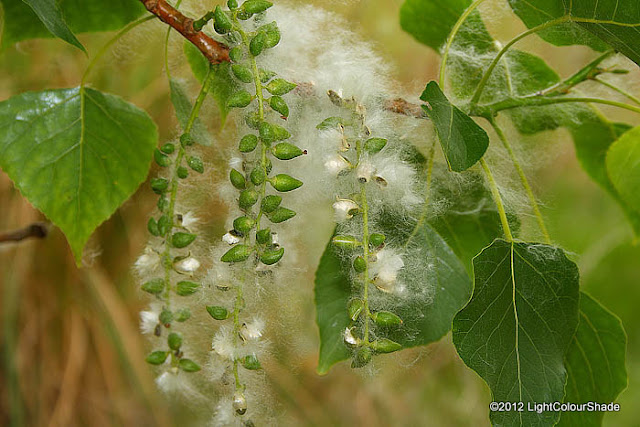 |
| Black poplar (Populus nigra) fluffy seeds. (© 2012 LightColourShade. All rights reserved) |
Catching the fleeting scenes of many splendored life
'Look closely. The beautiful may be small' — Kant
30 May 2012
Black Poplar (Populus nigra) Fluffy Seeds and Fluffy Clouds
These days black poplar (Populus nigra) trees' fluffy seeds float in the air, wrapping everything in a kind of cotton like down (hence the name cottonwood).
25 May 2012
Spring Colours. Pink and Red
European Redbud, Judas Tree (Cercis siliquastrum), and Red Poppy Field
More spring postcards.
Cercis siliquastrum, commonly known as Judas Tree (probably from Arbre de Judée meaning tree of Judea), is a small deciduous tree from Southern Europe and Western Asia.
It grows up to 12 metres in height and 10 metres in width. The deep pink flowers are produced on year-old or older growth, including the trunk in late spring (cauliflory). The heart-shaped leaves with a blunt apex, which occasionally has a shallow notch at the tip, appear shortly after the first flowers emerge. The tree produces long flat pods that hang vertically.
Cercis siliquastrum, commonly known as Judas Tree (probably from Arbre de Judée meaning tree of Judea), is a small deciduous tree from Southern Europe and Western Asia.
It grows up to 12 metres in height and 10 metres in width. The deep pink flowers are produced on year-old or older growth, including the trunk in late spring (cauliflory). The heart-shaped leaves with a blunt apex, which occasionally has a shallow notch at the tip, appear shortly after the first flowers emerge. The tree produces long flat pods that hang vertically.
 |
| European Redbud, Judas tree (Cercis siliquastrum) flowering twig (© 2012 LightColourShade. All rights reserved) |
22 May 2012
Beach on a cloudy day
11 May 2012
Flowering Trees.
Tamarix, Bottlebrush tree, Pōhutukawa, Silky oak and Goldenrain tree.
A flowering tree is always a feast for the eyes, and springtime is when most trees come into blossom.
The genus Tamarix (tamarisk, salt cedar) comprises about 50-60 species of flowering plants in the family Tamaricaceae, native to drier areas of Eurasia and Africa. The largest, Tamarix aphylla, is an evergreen tree that can grow to 18 m tall. They usually grow on saline soils, and also tolerate alkali conditions.
I ran into this beauty by chance while strolling in the pine forest.
The genus Tamarix (tamarisk, salt cedar) comprises about 50-60 species of flowering plants in the family Tamaricaceae, native to drier areas of Eurasia and Africa. The largest, Tamarix aphylla, is an evergreen tree that can grow to 18 m tall. They usually grow on saline soils, and also tolerate alkali conditions.
I ran into this beauty by chance while strolling in the pine forest.
 |
| Tamarix aphylla tree in full blossom (© 2012 LightColourShade. All rights reserved) |
5 May 2012
Medieval Castle
2 May 2012
Spring Colours: Red.
Poppies (Papaver rhoeas and Papaverum somniferum)
Spring is the best time to gather wildflowers. They pop out on every patch of soil, and so did a few tussocks of poppies in the nearby field. Unfortunately they wither too fast.
Common poppy or Papaver rhoeas (aka corn poppy, corn rose, field poppy, Flanders poppy, red poppy, red weed, coquelicot) is a species of flowering plant in the poppy family, Papaveraceae. This poppy, native to Europe, is sometimes considered an agricultural weed (hence the "corn" and "field") and a symbol of fallen soldiers.
Common poppy or Papaver rhoeas (aka corn poppy, corn rose, field poppy, Flanders poppy, red poppy, red weed, coquelicot) is a species of flowering plant in the poppy family, Papaveraceae. This poppy, native to Europe, is sometimes considered an agricultural weed (hence the "corn" and "field") and a symbol of fallen soldiers.
| Poppy flower (Papaver rhoeas) and glass. Red and Black. (© 2012 LightColourShade. All rights reserved) |
Subscribe to:
Comments (Atom)

